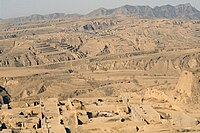
Photo from wikipedia
The present paper examines the nature of salt movement by the influence of landscape position and development of secondary salinity in Indira Gandhi Nahar Pariyojana command area of hot arid… Click to show full abstract
The present paper examines the nature of salt movement by the influence of landscape position and development of secondary salinity in Indira Gandhi Nahar Pariyojana command area of hot arid India. Soil samples were collected along 20 km transect across landscapes of upland, medium land, lowland and wetland. Soil properties, electrical conductivity of saturated extract (ECe), soluble ions in saturated extracts, exchangeable sodium percentage (ESP) and sodium adsorption ratio were determined. Results showed that cation exchange capacity, organic carbon and CaCO3 were significantly increased in lowland and wetland while soil pH, salinity indicators (ECe and ESP) and exchangeable cations and anions such as chloride and sulphate were increased significantly (P < 0.05) in the wetland. The mean exchangeable Na was increased while exchangeable Ca, Mg, and K decreased from upland to wetland landscape. It was found that Cl− imposed an existing and potential threat to sensitive crops in medium to wetland, where Cl− concentrations were greater than 106 me L−1. Principal component analysis helped in the identification of the parameters responsible for soil salinity variation, and the first factor indicated that soil ECe and ESP had a major role in the development of salinity and sodicity, respectively. Cluster analysis grouped four sampling sites into three clusters and members of the third cluster (lowland and wetland) were in close proximity. Under the prevalent arid conditions, improving the management of irrigation water should be the indispensable one to conserve and sustain the already fragile agricultural soils in the hot arid regions of India.
Journal Title: Environmental Earth Sciences
Year Published: 2019
Link to full text (if available)
Share on Social Media: Sign Up to like & get
recommendations!